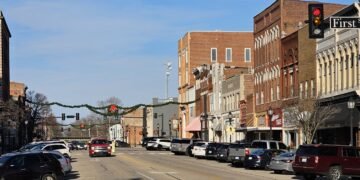It’s difficult to gauge the financial impact Churchill Downs moving its summer racing season to Ellis Park has had locally in the weeks since the shift.
But anecdotal evidence shows that people from all over the United States have visited Henderson’s venerable racecourse in June, according to Abby Dixon, the executive director of the Henderson Tourist Commission.
Dixon, who sets up a tourist commission table near one of the entrances on race days, said she’s talked to visitors from California, New York, Maine, Georgia, North Carolina, Nevada, Kansas and Missouri.
Research from the Kentucky Department of Tourism shows that Ellis Park is the second-highest ranked attraction for tourists coming from farther than 60 miles in the Green River Region, which includes Henderson, Daviess, Union, Webster, Hancock, Muhlenberg, Hopkins and McLean counties. The number one is Audubon State Park, Dixon said.
“I think the people coming are really charmed by what we offer here,” she said.
Using hotel vacancy to judge the impact of Churchill’s racing season move to Ellis also only provides murky, though positive, measurements. Dixon said with the W.C. Handy Blues and Barbecue Fest and high amounts of construction in Henderson, local hotels are often at capacity.
“Our hotels are often running at 100%,” she said.
“Ellis has always drawn visitors, but with the longer season and more glamorous races, I think that’s having a real impact,” Dixon said.
Of the notable races, the most impressive now scheduled at Ellis is the July 1 Stephen Foster Stakes, which would have been run at Churchill. It’s a Grade 1 Stakes race, the highest level of racing Ellis has ever hosted.
On June 2, Churchill Downs Inc. announced it was suspending racing at the track on June 7 after 12 horses had died in the spring meet. CDI said it needed to conduct a top-to-bottom investigation to determine the cause and solutions. Churchill’s racing season resumed at Ellis on June 10.
One speculation is that Churchill’s track could be problematic, though testing has thus far not shown that.
In an interview with the Hendersonian on June 10 at Ellis Park, hall of fame trainer D. Wayne Lukas said the track at Churchill Downs is fine.
“I don’t think Churchill’s track is the problem,” said Lukas, who has trained four Kentucky Derby winners, six Preakness Stakes winners and four Belmont Stakes winners. “I haven’t talked to any trainers who think there’s a problem.”
Meanwhile, Lukas said Ellis’ track is a “strong selling point.” He said the track’s forgiving surface is suitable to start two-year-olds on.
Lukas believes the answer to curtailing horse deaths is to allow veterinarians the ability to do more with horse health and has nothing to do with the track.

Gary Palmisano, the executive director of racing for Churchill Downs Inc., said the unfortunate circumstances of the horses’ deaths caused the track to conduct a “top to bottom review” which required racing to cease so that a thorough investigation can be conducted.
Palmisano said Dr. Mick Peterson, considered the top authority on track surfaces, is currently studying Churchill Downs’ surface. So far, the track data is consistent with past levels. Peterson tested the track once before the Kentucky Derby and has tested it three times since, Palmisano said. They’re not seeing anything different than past checks, he said.
The investigation is multi-factor, including necropsy reports, track specimen study and interviews with trainers, among other pieces. They’re also studying the Equine Injury Database, Palmisano said.
Churchill brass discussed other possibilities but “we felt it was most prudent to move the meet to Ellis Park,” Palmisano said.
Turfway Park, another CDI subsidiary in Florence, has only a synthetic track, whereas Ellis has both turf and dirt, like Churchill.
Though Ellis’ meet wasn’t scheduled to begin until July, horses have been training at the track since May with good results—another reason to move Churchill’s meet, Palmisano said.
Finally, though CDI owns other tracks outside of Kentucky, the company could only move to a track in the commonwealth because purse money generated in Kentucky must stay in the state, Palmisano said.
Palmisano agreed with Lukas’ assessment of Ellis’ track, saying the common response of horsemen is high praise for the surface.
“They rave about the track at Ellis,” he said.
Palmisano said there are reasons for local race fans to be excited for Ellis Park’s future.
Even before the move, the company had scheduled a graded stakes race at Ellis, which had not occurred at the local course previously. The Pucker Up Stakes, a Grade 3 stakes, will be Sunday, Aug. 6.
Additionally, the company raised purses for Ellis’ normal meet, starting July 7. Palmisano said that purse money is trending toward $15 million for the meet, which runs through Aug. 27. Last summer’s purse money was just shy of $10 million, he said. The higher payoff will attract bigger name trainers, jockeys and horses, he said.
The company is also looking to boost purse money, he said. Purses for maiden special weight races will start at $70,000. Last year, they started at $50,000 and were boosted to $60,000 mid-meet, Palmisano said.
The long-term goal is for those purses to reach $100,000, Palmisano said. This would entice horsemen to come to Ellis during the July-August meet and stay in Kentucky year-round, instead of leaving for a higher-paying track elsewhere in the country.
“Our company is extremely excited about Ellis Park,” he said. “We’re excited about the community in Henderson.”




















